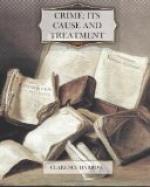XIX
MEDICAL EXPERTS
So long as the ordinary ideal of punishment prevails, a crime must consist of an act coupled with an intent to do the thing, which probably means an intent to do evil. This is no doubt the right interpretation of intent, although cases can be found, generally of a minor grade, which hold that evil intent is not necessary to the crime. Under the law as generally laid down, insanity is a defense to crime when the insanity is so far advanced as to blot out and obliterate the sense of right and wrong or render the accused unable to choose the right and avoid the wrong. Of course, legal definitions of scientific terms, processes, or things, do not ordinarily show the highest wisdom. It is safe to say that few judges or lawyers have ever been students of insanity, of the relation of “will” to “conduct,” or of other questions of science or philosophy. Each man confines himself to his field of operation, and the love of living does not induce him to go far from the matter in hand, which to him means the base of supplies.
The insane are exempted from punishment for crime on the ground that they are not able to prepare and attend to their cases when placed on trial and on the further ground that their “free will” is destroyed by disease or “something else,” and therefore they could form no intent. In another place I have tried to point out the fact that the acts of the sane and the insane are moved by like causes, but this is not the theory of the law.
Insanity is often very insidious. Many cases are easily classified, but there is always the border line, the twilight zone, which is sure to exist in moral questions and in all questions of human conduct, and this is hard to settle. It is generally determined by the feelings of a jury, moved or not by the prejudice of the public, depending on whether the community has been lashed or persuaded to take a hand in the conduct of the case.




